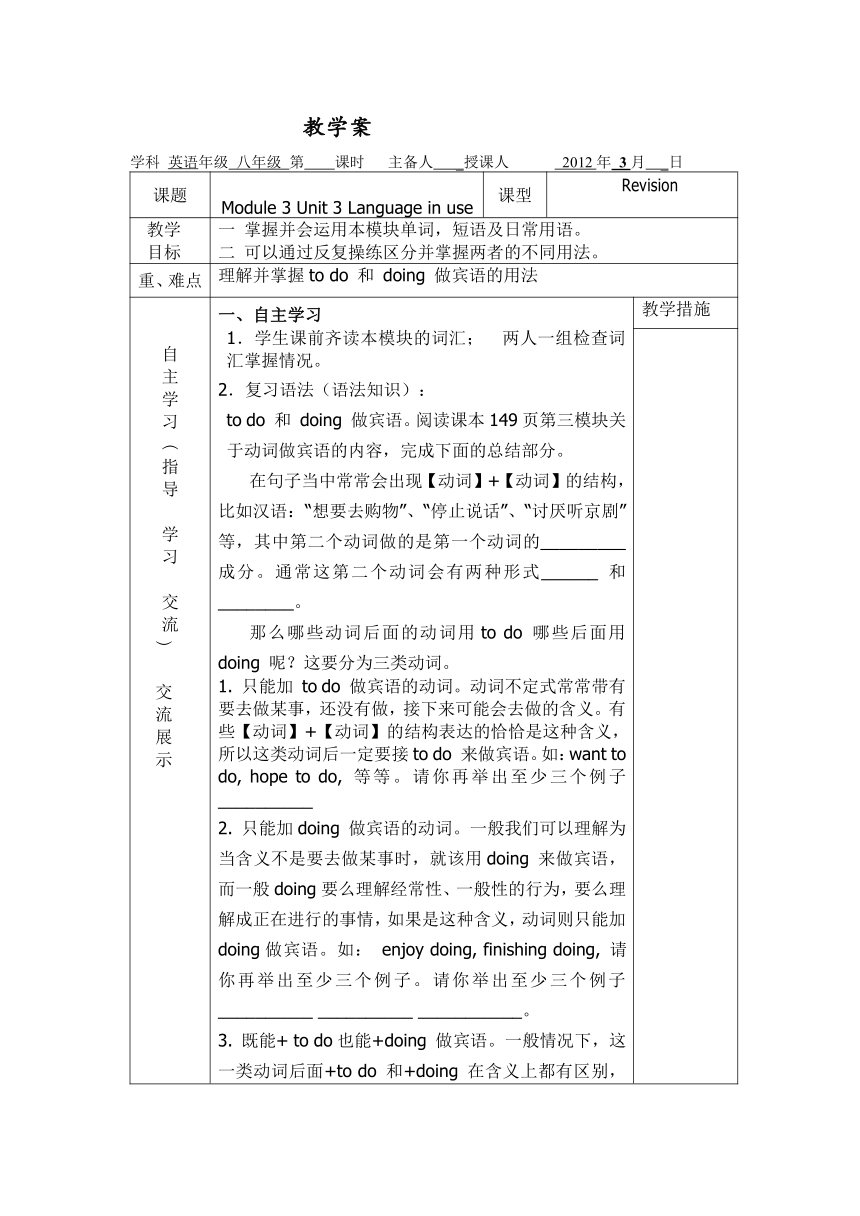八年级下>Module 3 On the radio>Unit 3 Language in use
文档属性
| 名称 | 八年级下>Module 3 On the radio>Unit 3 Language in use |  | |
| 格式 | zip | ||
| 文件大小 | 14.0KB | ||
| 资源类型 | 教案 | ||
| 版本资源 | 外研版 | ||
| 科目 | 英语 | ||
| 更新时间 | 2012-04-11 20:06:11 | ||
图片预览

文档简介
教学案
学科 英语年级 八年级 第 课时 主备人 _授课人 2012年 3月 _日
课题 Module 3 Unit 3 Language in use 课型 Revision
教学目标 一 掌握并会运用本模块单词,短语及日常用语。二 可以通过反复操练区分并掌握两者的不同用法。
重、难点 理解并掌握to do 和 doing 做宾语的用法
自主学习︵指导学习交流︶交流展示 一、自主学习1.学生课前齐读本模块的词汇; 两人一组检查词汇掌握情况。2.复习语法(语法知识):to do 和 doing 做宾语。阅读课本149页第三模块关于动词做宾语的内容,完成下面的总结部分。在句子当中常常会出现【动词】+【动词】的结构,比如汉语:“想要去购物”、“停止说话”、“讨厌听京剧”等,其中第二个动词做的是第一个动词的_________成分。通常这第二个动词会有两种形式______ 和 ________。那么哪些动词后面的动词用to do 哪些后面用 doing 呢?这要分为三类动词。1. 只能加 to do 做宾语的动词。动词不定式常常带有要去做某事,还没有做,接下来可能会去做的含义。有些【动词】+【动词】的结构表达的恰恰是这种含义,所以这类动词后一定要接to do 来做宾语。如:want to do, hope to do, 等等。请你再举出至少三个例子 __________ 2. 只能加doing 做宾语的动词。一般我们可以理解为当含义不是要去做某事时,就该用doing 来做宾语,而一般doing要么理解经常性、一般性的行为,要么理解成正在进行的事情,如果是这种含义,动词则只能加doing做宾语。如: enjoy doing, finishing doing, 请你再举出至少三个例子。请你举出至少三个例子 __________ __________ ___________。3. 既能+ to do也能+doing 做宾语。一般情况下,这一类动词后面+to do 和+doing 在含义上都有区别,只是个别几个动词,不去强调两种宾语之间的区别了。如: start to do/doing, begin to do/ doing,continue to do/doing。但是大部分动词还是要强调区别的,如:remember to do, 记得要去做某事(还没做)。 remember doing sth. 记得做过某事(已做过)forget to do sth. 忘记做某事(没做) forget doing sth. 忘记做过某事。(忘记做过的事)stop to do sth. 停下来去做某事(停下来去做另一件事) stop doing sth.停止做某事二、合作学习请用所给动词的适当形式填空。1. Lucy wants __________(borrow) a new bicycle.2. When I finished ___________(do) my homework, I helped mum with housework.3. Many people enjoy ___________(collect) stamps.4. You need ___________(look) after yourself .5. I remembe__(play) with you when we were children.6. If you want to be a presenter. Please keep _(study).7. On my way home, I stopped ____(buy) a newspaper.8. She started ______(learn) English at the age of five.二.用所给词的正确形式填空1. I enjoy ________(skate) in winter.2. What do you want ________(be) in the future 3. I feel like ________(take) some pictures.4. I am trying ________(catch) the bus.5. You need ________(write) an article for the newspaper.三、课堂小结to do 和 doing 做宾语四、布置作业完成互动上的练习题 教学措施
Step 1: Dictation Have a dictation about Module1 and let thestudents check with each other..Step2 Preview Let the students preview the Difficultpoints individuallyStep3 ExplanationAsk the students tospeak firstand then the teacher summary.Step4 Get the students talk about it and remember itStep6: Explaining Get the students to find out the points and talk aboutthem with theeach otherthe teacher explain the following
学科 英语年级 八年级 第 课时 主备人 _授课人 2012年 3月 _日
课题 Module 3 Unit 3 Language in use 课型 Revision
教学目标 一 掌握并会运用本模块单词,短语及日常用语。二 可以通过反复操练区分并掌握两者的不同用法。
重、难点 理解并掌握to do 和 doing 做宾语的用法
自主学习︵指导学习交流︶交流展示 一、自主学习1.学生课前齐读本模块的词汇; 两人一组检查词汇掌握情况。2.复习语法(语法知识):to do 和 doing 做宾语。阅读课本149页第三模块关于动词做宾语的内容,完成下面的总结部分。在句子当中常常会出现【动词】+【动词】的结构,比如汉语:“想要去购物”、“停止说话”、“讨厌听京剧”等,其中第二个动词做的是第一个动词的_________成分。通常这第二个动词会有两种形式______ 和 ________。那么哪些动词后面的动词用to do 哪些后面用 doing 呢?这要分为三类动词。1. 只能加 to do 做宾语的动词。动词不定式常常带有要去做某事,还没有做,接下来可能会去做的含义。有些【动词】+【动词】的结构表达的恰恰是这种含义,所以这类动词后一定要接to do 来做宾语。如:want to do, hope to do, 等等。请你再举出至少三个例子 __________ 2. 只能加doing 做宾语的动词。一般我们可以理解为当含义不是要去做某事时,就该用doing 来做宾语,而一般doing要么理解经常性、一般性的行为,要么理解成正在进行的事情,如果是这种含义,动词则只能加doing做宾语。如: enjoy doing, finishing doing, 请你再举出至少三个例子。请你举出至少三个例子 __________ __________ ___________。3. 既能+ to do也能+doing 做宾语。一般情况下,这一类动词后面+to do 和+doing 在含义上都有区别,只是个别几个动词,不去强调两种宾语之间的区别了。如: start to do/doing, begin to do/ doing,continue to do/doing。但是大部分动词还是要强调区别的,如:remember to do, 记得要去做某事(还没做)。 remember doing sth. 记得做过某事(已做过)forget to do sth. 忘记做某事(没做) forget doing sth. 忘记做过某事。(忘记做过的事)stop to do sth. 停下来去做某事(停下来去做另一件事) stop doing sth.停止做某事二、合作学习请用所给动词的适当形式填空。1. Lucy wants __________(borrow) a new bicycle.2. When I finished ___________(do) my homework, I helped mum with housework.3. Many people enjoy ___________(collect) stamps.4. You need ___________(look) after yourself .5. I remembe__(play) with you when we were children.6. If you want to be a presenter. Please keep _(study).7. On my way home, I stopped ____(buy) a newspaper.8. She started ______(learn) English at the age of five.二.用所给词的正确形式填空1. I enjoy ________(skate) in winter.2. What do you want ________(be) in the future 3. I feel like ________(take) some pictures.4. I am trying ________(catch) the bus.5. You need ________(write) an article for the newspaper.三、课堂小结to do 和 doing 做宾语四、布置作业完成互动上的练习题 教学措施
Step 1: Dictation Have a dictation about Module1 and let thestudents check with each other..Step2 Preview Let the students preview the Difficultpoints individuallyStep3 ExplanationAsk the students tospeak firstand then the teacher summary.Step4 Get the students talk about it and remember itStep6: Explaining Get the students to find out the points and talk aboutthem with theeach otherthe teacher explain the following
同课章节目录
- Module 1 Feelings and impressions
- Unit 1 It smells delicious.
- Unit 2 I feel nervous when I speak Chinese .
- Unit 3 Language in use
- Module 2 Experiences
- Unit 1 I've also entered lots of speaking competi
- Unit 2 They have seen the Pyramids.
- Unit 3 Language in use
- Module 3 Journey to space
- Unit 1 Has it arrived yet?
- Unit 2 We have not found life on any other planet
- Unit 3 Language in use
- Module 4 Seeing the docto
- Unit 1 I haven't done much exercise since I got m
- Unit 2 We have played football for a year now
- Unit 3 Language in use
- Module 5 Cartoons
- Unit 1 It's time to watch a cartoon.
- Unit 2 Tintin has been popular for over eighty yea
- Unit 3 Language in use
- Revision module A
- Module 6 Hobbies
- Unit 1 Do you collect anything ?
- Unit 2 Hobbies can make you grow as a person.
- Unit 3 Language in use
- Module 7 Summer in Los Angeles
- Unit 1 Please write to me and send me some photos
- Unit 2 Fill out a form and come to learn English
- Unit 3 Language in use
- Module 8 Time off
- Unit 1 I can hardly believe we are in the city ce
- Unit 2 We thought somebody was moving about
- Unit 3 Language in use
- Module 9 Friendship
- Unit 1 Could I ask if you've mentioned this to he
- Unit 2 I believe that the world is what you think
- Unit 3 Language in use
- Module 10 On the radio
- Unit 1 I hope that you can join us one day
- Unit 2 It seemed that they were speaking to me in
- Unit 3 Language in use
- Revision module B
